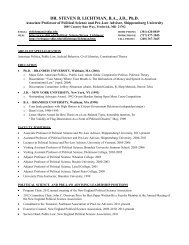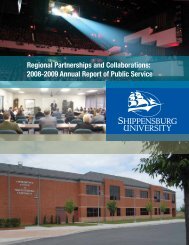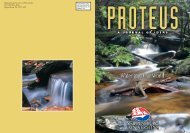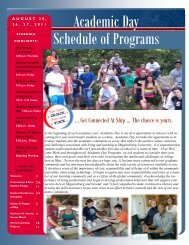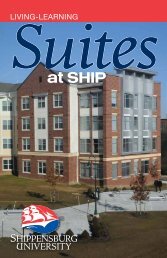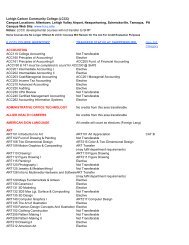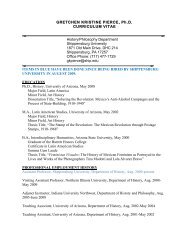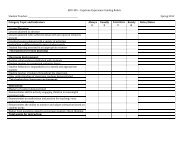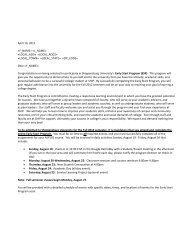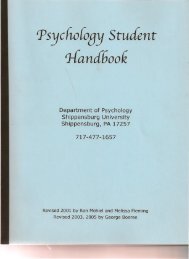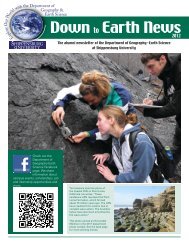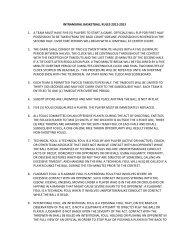Graduate Catalog - Shippensburg University
Graduate Catalog - Shippensburg University
Graduate Catalog - Shippensburg University
Create successful ePaper yourself
Turn your PDF publications into a flip-book with our unique Google optimized e-Paper software.
Courses of InstructionGEO503 Fundamentals of Geoenvironmental Research (3 crs.)Builds student skills common to developing, implementing, and disseminatingresearch projects in the major sub-disciplines of geoenvironmentalstudies. Generates opportunities to develop critical reading,writing, and presentation skills. Students will develop a literaturereview and a research proposal, as would be appropriate for eitheran independent research project or a master’s thesis. Also developsfundamental skills for preparing grant proposals, professional reports,and oral and graphic presentations. Restricted to Geoenvironmentalmajors.GEO514 Urban Environment (3 crs.)Examines the impact of information technologies (IT) on the arrangementof human activities. The new technologies in informationshould make it possible to share information on a global scale. Informationon problems ranging from hunger, employment opportunities,environmental degradation, traffic congestion, housing, and manyother situations can be shared in a very short span of time over vastareas. Explores the problems and prospects for using informationtechnology to communicate with people in similar or very differentcultural and physical environments to guide the growth and developmentof human activities.GEO517 Applied Geographic Information Systems (GIS) (3 crs.)Reviews advanced geographic information systems (GIS) applicationsand the use of geographic information management technology inenvironmental analysis. Spatial mapping and data applications willbe related to renewable resource management, transportation andlogistics, infrastructure management, natural resources and land useplanning, public health and safety, environmental hazards, mineralexploration, environmental assessment and monitoring, map and databaseanalysis and research and education. Emphasis is on how GIScan assist in answering questions, solving problems, and analyzingspatial data. State-of-the-art GIS software used to show applicationsof geographic information technology for geoenvironmental andnatural resource management projects.GEO522 Geoenvironmental Hydrology (3 crs.)Focuses on components of the hydrologic cycle including humidity,precipitation, interception, infiltration, soil moisture, evaporation,ground water, and stream flow. Particular emphasis is placed onusing models to analyze these hydrological components and addresspractical hydrological issues such as storm water management,erosion, water quality, and stream and wetland restoration. Localwater resources and watersheds are used as the basis for projects andfield reports. Many projects will focus on human alterations to thehydrological system.GEO524 The Geologic Environment (3 crs.)Concerned with major concepts of physical and applied geology andtheir relationship to human activity. Analysis of minerals and rocks,earth structures, global tectonics, and surficial processes examined in alecture, laboratory, and field investigation format.GEO528 Geography of Economic and Environmental Systems (3 crs.)Interpretative survey of the effects manufacturing and economicactivities have on land-use development and the environment.Techniques of economic-industrial analysis, mapping procedures,environmental planning policies, and field study of the local regionare utilized.GEO530 Mapping Sciences (3 crs.)Advanced methods in computer-assisted mapping and map analysis(geographic information systems or GIS). Emphasis placed upontechniques of establishing, managing spatial (geographic) data bases,cartographic modeling and analysis, and digital map compositionusing state-of-the-art GIS software. One hour lecture, three hours computerlaboratory per week.GEO531 Geomorphology (3 crs.)Geomorphology is the systematic description, analysis, and interpretationof landscapes and the processes that change them. Emphasizesboth the qualitative and quantitative aspects of landscape changeand has three principal objectives: 1) to provide a solid grounding inthe basic concepts of process and Quaternary geomorphology, 2) toapply these concepts to the central Appalachian Highlands region,and 3) to examine these relationships in the field. Consists of in‐classlecture, discussion, laboratory assignments, outside readings, a writtenpaper and presentation, a local field trip, and a two-day field tripto Maryland and Virginia. Prerequisite: introductory geology course orequivalent.GEO532 Disease and the Environment (3 crs.)Seminar in geoenvironmental health hazards such as solid waste,air, and water pollution. Emphasis on public health problems thesehazards pose, the application of geographic methods, and tools ofanalysis. Means available to cope with geoenvironmental hazards andassociated policy debates are examined. Lecture information limited.Students expected to participate actively in every seminar meeting.GEO533 Science of Land Use Change (3 crs.)Land use and land cover change can have dramatic social and ecologicalconsequences. This seminar course will focus on understandingand recognizing drivers of land use and land cover change andon recognizing linkages between land use and land cover change andother ecosystem processes, such as hydrologic processes and habitatfragmentation. The course will also focus on methods for analyzingland use and land cover changes, landscape patterns, and will incorporategeographic information systems and modeling. Prerequisite:introductory course in geographic information systems.GEO536 Problems of the Atmospheric Environment (3 crs.)Examines and analyzes various weather and climate topics, bothnatural and human-influenced. Topics include brief review of atmosphericbasics, air pollution, ozone, ENSO, climate change, climatemodeling, and greenhouse warming. Potential solutions to problemsexplored. Presented in seminar format and includes journal paperdiscussion and evaluation, writing opinion papers on controversialatmospheric issues, group projects, class presentations, and a termpaper. Interrelationships among the various atmospheric problems areemphasized.GEO542 Land-Use Regulations (3 crs.)Provides knowledge of the components of community level land useregulations. The following community level system components areexamined: comprehensive plan, zoning ordinance, subdivision regulations,taxation, other minor land acquisition techniques.GEO546 Geoenvironmental Research I (3 crs.)Research course to be developed with member of the geographyearthscience department.GEO548 Geoenvironmental Research II (3 crs.)Research course to be developed with member of the geographyearthscience department.GEO594 Selected Topics (1-3 crs.)GEO599 Independent Study (3 crs.)GEO609 Internship I (3 crs.)Provides opportunity to practice geoenvironmental theory andconcepts as an observer and participant in the process. Placement ona limited basis with consulting firms and state and local governmentsenhances the student’s preparation in the field.GEO610 Internship II (3 crs.)Provides opportunity to practice geoenvironmental theory andconcepts as an observer and participant in the process. Placement ona limited basis with consulting firms and state and local governmentsenhances the student’s preparation in the field.GEO612 Thesis I (3 crs.)GEO613 Thesis II (3 crs.)93



